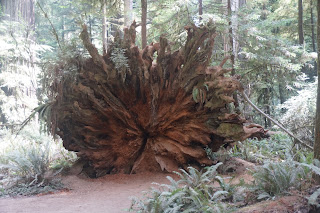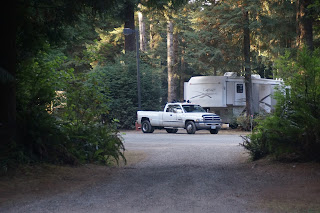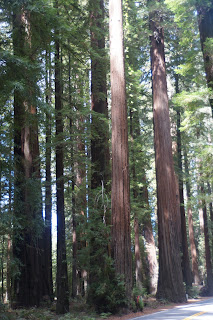FRIDAY,
AUGUST 28:
After
a morning of doing laundry and then relaxing, we had a chance of pace
from forests. We drove into town in the afternoon to the harbor
area, where we wanted to see the Battery Point Lighthouse. This
lighthouse is operated strictly by volunteers, and is only open at
limited times, partly dictated by the tides . . . to get there, you
have to walk across an area exposed only at low tide.

The
tour was great, done by the 4 volunteers (2 husband-wife teams).
Gave the history of this lighthouse (built in 1856, California's 10th
), introduced some of the keepers who lived in it, a few of their
original furnishings, a couple of the tragic stories which took place
in the sea close by. We climbed to the top of the Cape Cod style
dwelling (this type of lighthouse meant that the narrow circular
stairs to the top were built right into the center of the house, so
that the keeper wouldn't need to go outdoors in the nasty elements to
change the oil for the light nor the weights for the clock which
turned it, nor for any other myriad of jobs surrounding the keeping
of the light).
At
the top we saw the 5th
order Fresnel lens, which is still being operated (automated) on a
voluntary basis; the official lighthouse was de-commmissioned in the
1950's. But apparently some boats still depend on it; if the light
goes out for some reason, the first thing the resident lightkeeper
does is notify the U.S. Coast Guard.
The
Del Norte County Historical Society, which owns & operates the
lighthouse, has a unique system which we've never encountered in our
numerous tours of lighthouses in the past couple of years. They
enlist volunteers to actually live in the lighthouse year-round, for
a month at a time. They are the ones who host the tours, and
maintain the upkeep of the lighthouse. So one pair of our guides has
been living there since August 1; they're from Neosho, MO! There is
a 3-year wait list to get to stay here!
This
would be a perfect way to get to storm-watch in the winter! And as
safe as you could get . . . when the tsunami created in 1964 by the
Good Friday Alaskan earthquake hit here, it destroyed a good part of
the town and killed 11 people. But it didn't affect the 2-feet thick
stone walls of the lighthouse. Same with the 2011 tsunami from the
Japan earthquake – destroyed several boats in the town's harbor,
but nothing at the lighthouse. In fact, our guide told the story of
an 88-foot wave which crashed over the 70+ foot lighthouse a few
years ago . . . would have been both thrillng and terrifying to live
through that – but it did absolutely no damage to Battery Point.
Hmmmm . .. maybe we'll look into it!
It
was a fairly clear afternoon, so we had some pretty nice views from
the grounds and up at the top. Some of the last views of the coast
and ocean we'll have on this trip.




















































